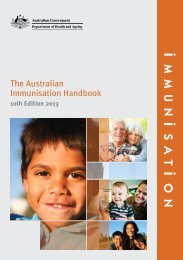Contents Chapter Topic Page Neonatology Respiratory Cardiology
Contents Chapter Topic Page Neonatology Respiratory Cardiology
Contents Chapter Topic Page Neonatology Respiratory Cardiology
You also want an ePaper? Increase the reach of your titles
YUMPU automatically turns print PDFs into web optimized ePapers that Google loves.
Once the baby is on phototherapy, visual observation as a means of monitoring is<br />
unreliable. Serum bilirubin levels must guide the management.<br />
EXCHANGE TRANSFUSION (ET)<br />
Bilirubin levels beyond which kernicterus may occur if an ET is not carried out have not<br />
been established. The modality of treatment should be based on the clinical history, risk<br />
factors and physical examination of the infants. The table below illustrates the<br />
recommended levels for various modalities of treatment adapted from the American<br />
Academy Pediatrics for infants of 35 or more weeks of gestation based on different<br />
levels of risk. (Pediatrics 2004, 114: 297-316).<br />
Table 2. Guidelines for Phototherapy and ET in Hospitalised Infants of 35 or More<br />
Weeks’ Gestation<br />
Hours<br />
of life<br />
Infants at lower risk (≥ 38<br />
wk and well)<br />
Intensive<br />
Phototherapy<br />
Total Serum Bilirubin levels mg/dL (umol/L)<br />
Infants at medium risk (≥<br />
38 wk + risk factors OR 35-<br />
37 6/7 wk and well)<br />
ET Intensive<br />
Phototherapy<br />
Infants at higher risk (35-<br />
37 6/7 wk + risk factors)<br />
ET Intensive<br />
Phototherapy<br />
< 24*<br />
24 12 (200) 19 (325) 10 (170) 17 (290) 8 (135) 15 (255)<br />
48 15 (255) 22 (375) 13 (220) 19 (325) 11 (185) 17 (290)<br />
72 18 (305) 24 (410) 15 (255) 21 (360) 13 (220) 18.5 (315)<br />
96 20 (340) 25 (425) 17 (290) 22.5 (380) 14 (240) 19 (325)<br />
> 96 21 (360) 25 (425) 18 (305) 22.5 (380) 15 (255) 19 (325)<br />
Note:<br />
1. Immediate exchange transfusion is recommended if infants show signs of acute bilirubin<br />
encephalopathy (hypertonia, arching, retrocollis, opisthotonus, fever, high pitch cry) or if<br />
TSB is ≥ 5 mg/dL (85 umol/L) above the exchange levels stated above.<br />
2. Start conventional phototheraphy at TSB 3 mg/dL (50 umol/L) below the levels for<br />
intensive phototherapy.<br />
3. Risk factors – isoimmune hemolytic disease; G6PD deficiency, asphyxia, significant<br />
lethargy, temperature instability, sepsis, acidosis or albumin < 3.0 g/dL<br />
4. Use total bilirubin. Do not subtract direct reacting or conjugated bilirubin.<br />
5. During birth hospitalisation, ET is recommended if the TSB rises to these levels despite<br />
intensive phototherapy<br />
6. For readmitted infants, if the TSB level is above the ET level repeat the TSB<br />
measurement every 2 to 3 hours and consider ET if the TSB levels remain above the ET<br />
level for 6 hours under intensive phototherapy<br />
7. *Infants jaundiced at < 24 hours of life are not considered healthy and require further<br />
evaluation.<br />
Infants who are of lower gestation will require phototherapy and ET at lower levels,<br />
(please check with your specialist)<br />
ET
















